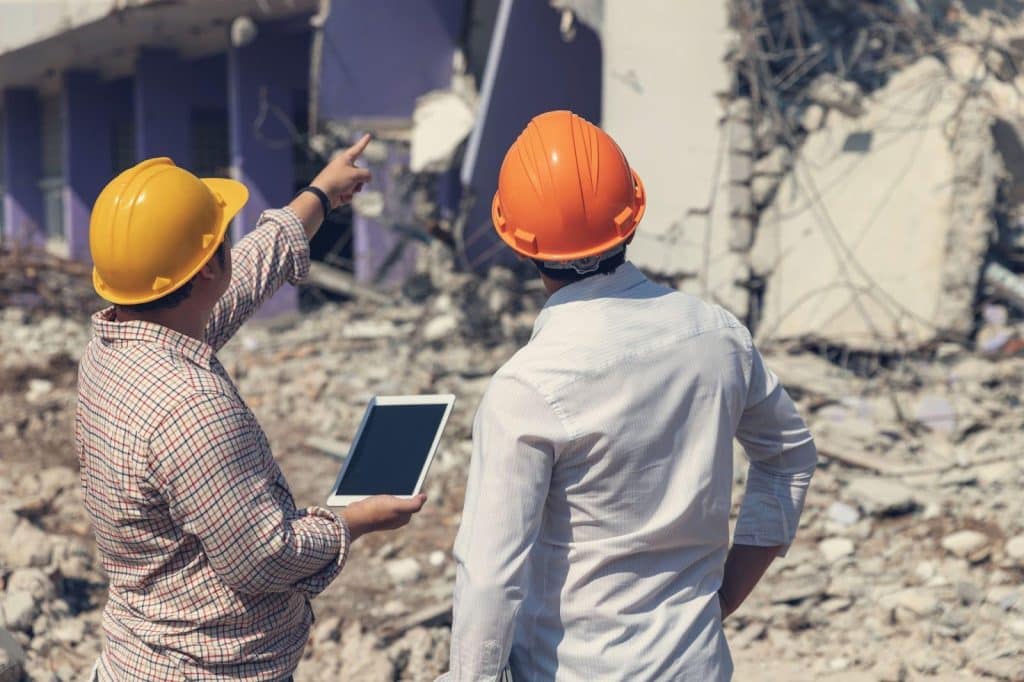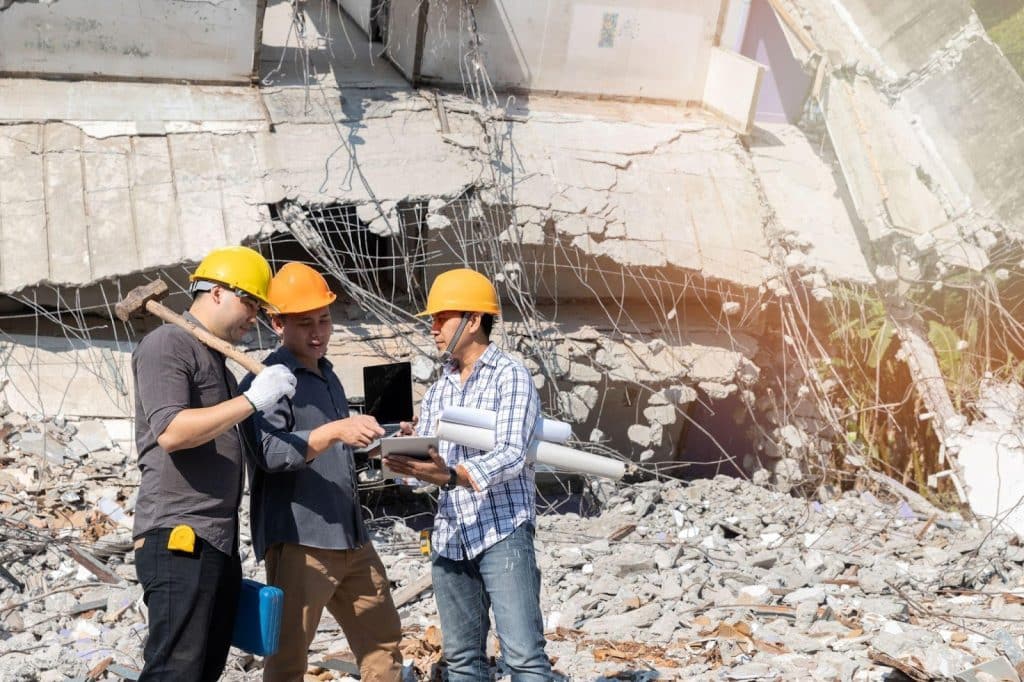
As a demolition professional, you understand the importance of proper demolition management planning and compliance. Every demo job has a list of safety hazards that are both serious and maintain severe and dire outcomes for any unfortunate souls who don’t follow site guidelines. Managing multiple teams, contractors, and site safety compliance is a big job and responsibility; luckily, we’re here to help.
Creating an efficient demolition management plan to meet and exceed safety and regulatory requirements is necessary. With the right tools, it’s not as big or complicated a job as you think.
The key to a successful project is careful planning, safe operations, and good management. In this article, we will discuss some of the challenges demolition contractors and professionals face. We’ll look at some of the challenges to regulatory compliance and offer some fantastic solutions to help you manage your demolition projects more straightforward, more efficiently, and above all, increase safety. Let’s start with some challenges and how to approach mitigation best.
Common Challenges in Demolition Management Planning & Compliance

Construction and demolition sites have one thing in common: they have more safety hazards than you can shake a stick at. But safety isn’t the only challenge you face on-site or the only thing you must manage. Let’s look at the eight major factors contributing to difficulties for demolition teams and how to mitigate each.
Dismantling Safety
Depending on the scope of work, your demolition team may need to first dismantle any number of constructions following the engineering survey of the site. Dismantling hosts several safety challenges and can lead to regulatory infractions or, worse, injuries to your team.
Sequencing Job Challenges
If incorrectly dismantled, sequential dismantling procedures for complex constructions may pose several severe hazards.
Sequencing Solutions
We recommend utilizing a procedural checklist. For example, let’s say you have new staff who need guidance about handling an incident like a team member injury. You could create a procedural injury incident checklist (like the one linked here). If an incident arises, your new team members have a sequence of actions to take following a simple yet highly effective checklist.
Hazardous Materials Challenges
During some dismantling procedures, your team may encounter hazardous materials.
Haz. Mat. Solutions
Before commencing work, have your team members perform a Job Hazard Analysis. Identifying hazards is most crucial in adequately preparing the correct Personal Protective Equipment.
Equipment Management
Demolition projects require several different pieces of equipment. Furthermore, team members must possess the appropriate training, certifications, and licenses to operate the equipment appropriately. However, these are obvious points. What is not so obvious is how to comply with vehicular and equipment use regulations.
Training & Certification
Training and certification for vehicular or equipment operations are critical to maintaining safe and compliant demolition operations. The challenge is often keeping track of the various licenses and certifications your many team members require.
Training & Certification Solutions
We recommend that you appoint a project safety officer. Give that officer the responsibility of creating, managing, and maintaining training records for your team. Create a shared calendar and have your safety officer note each team member’s training expiration date. Set reminders for an appropriate period in advance, and your safety officer will easily maintain the program.
Equipment/Vehicle Inspection
According to OSHA standard 1926.601(b)(14), “All vehicles in use shall be checked at the beginning of each shift…”
Given the above, it’s wise to implement a vehicle or equipment daily walk-around inspection checklist. The challenge here is three-fold:
- Having personnel complete a thorough inspection efficiently and promptly.
- Dealing with equipment or vehicular inspection failures promptly to avoid downtime.
- Maintaining documentation of inspections, repairs, and vehicle use.
There are some great solutions, but we recommend using a single digital solution to manage all three: our reporting application, 1st Reporting. With 1st, you can create a custom vehicle or equipment inspection report or use the one that comes standard in our applications template library.
The app allows you to create dynamic checklists and force field completion so your team cannot skip a step, keeping the inspections on track and standardized across your team. Furthermore, you can dynamically link the report to a repair report, for example, so tracking follow-up vehicle or equipment repairs is easy.
Using a digital platform for completing vehicle and equipment inspections also means you won’t have to deal with paper reports that can come in dirty, illegible, or go missing altogether. With our secure cloud-based application, all reports, checklists, and data are stored securely in the cloud, legible, and awaiting your review.
Estimation & Job Cost Tracking
Estimation, job cost tracking, and analysis are critical elements of any demolition project. You must provide accurate data to your potential clients and know all the hidden costs. Often this means completing a site inspection to understand what you are up against.
Estimation and Job Costing Solutions
Site condition reports are a great way to understand the site. Furthermore, you could create a customized demolition estimating form within the 1st Reporting app that you could use to standardize your estimating processes.
Utilizing checklists and form templates to standardize your estimating process is a fantastic way to bring efficiency into the mix. However, you can use the same approach to maintain solid records and understand your job costs in greater detail when it comes to job costing.
OSHA & Regulatory Compliance
Maintaining the appropriate documentation is one of the biggest challenges to any construction or demolition project. You need copies of team training, utility locates, city permits, and much more. Due to the complexity of these jobs, it can be far too easy to lose track of one document or another and equally easy to cut corners to save time.
Due to the severe nature of the hazards at a demolition site, you don’t have the luxury of lax regulatory compliance. Not only that but due to the nature of the work, you can almost always guarantee a visit from a government official at one point or another during the demolition. So, how to best solve this dilemma? Once again, it’s 1st Reporting to our rescue.
Regulatory Compliance Solutions
As you know, ensuring your team works safely and within the scope of regulations is essential. In order to track and maintain the various records, documents, training, and safety equipment to keep your team safe, you’ll need a robust reporting system like 1st Reporting. With a flexible smart app like 1st, you can create all the custom forms your team needs. Furthermore, it’s easy to set up custom notifications, so you can get notified the moment your team members complete a report.
Safety
Safety is one of a demolition project’s most essential and difficult-to-manage aspects. Ensuring that each team member works safely is a challenge, mainly when your team is scattered about a large site, each completing its separate tasks.
Several aspects of site safety come to mind for demolition sites:
- PPE Compliance
- Signage
- Utilities
- Lockout/Tagout
- Training
In terms of compliance, if your site has anywhere above six feet, you’ll need to consider fall arrest/prevention equipment and training. Your team members will need to complete a daily fall arrest harness inspection, and there’s no better tool than 1st Reporting.
Your team can use 1st Reporting on their smartphones, tablets, laptops, or even desktop computers, but the real value shows when you work with remote teams or have team members in different locations.
The application works even when the team member’s equipment is out of range of a network signal. The app will store their data locally until the device can communicate with the cloud again. This way, you and your team never lose information again.
The application also works well for creating safety checklists like the Preparatory Demolition Checklist – a checklist to help you manage your demolition project preparations.
I don’t need to explain the importance of appropriately managing safety on a demolition project. That’s one of the many reasons why we built 1st Reporting. Because safety is number one, and now we all have an easier way to manage it.
More Tips for Efficient Demolition Management Planning & Compliance

To make things easier for you, here is a summary of the challenges we’ve compiled to help you better manage your demolition project.
- Dismantling Safety: Dismantling structures can pose safety risks and regulatory challenges.
- Sequencing Job Challenges: Sequential dismantling of complex structures requires careful planning to avoid hazards.
- Hazardous Materials Challenges: Demolition teams may encounter hazardous materials during dismantling procedures.
- Equipment Management: Proper training, certification, and inspection are essential to ensure safety and compliance.
- Estimation & Job Cost Tracking: Accurate estimates and job cost tracking are essential for successful demolition projects.
- OSHA & Regulatory Compliance: Maintaining appropriate documentation and compliance with regulations is critical.
- Safety: Ensuring safety on demolition sites involves PPE compliance, signage, utilities, lockout/tagout, and training.
To mitigate these challenges, we recommend using a reporting application called 1st Reporting. This app allows the creation of custom forms, checklists, and notifications to help manage safety and compliance. It also enables tracking training records, equipment inspections, job costs, and more, depending on the data you want to collect. The application is mobile, secure, and cloud-based. You can find it by signing up here on this site or downloading and installing the application on your smartphone via Google Play or The Apple App Store.
We recommend that you:
- Create a demolition project plan outlining the responsibilities of each individual.
- Appoint a responsible person to the site safety officer and ensure they manage your project plan.
- Train your team members on best reporting practices and have each install the 1st Reporting app on their company smartphones.
- Create customized procedural checklists for complex dismantles and other procedures to ensure standardized and safe operations.
- Utilize the 1st Reporting report management system, where you can see the GPS locations of each report submission on one of the many customizable views.
The Benefits of Using a Safety Inspection Application

There’s more to using the industry standard 1st Reporting application than meets the eye. Our application has innovative features baked into its framework. Those features make the archaic paper forms of old look like the 3,000-year-old technology they are – in today’s world, we no longer have to bow to the paper gods of old.
A few of the benefits of using 1st Reporting as your site safety reporting go-to option:
- Custom notifications for faster communications
- The ability to include media to support observation claims (photo, video, and even audio files are easily uploaded)
- Increased accountability and record-keeping via dynamic form linking and tracking
- Custom-generated reports for ultimate trend analysis
Summary
With the right tools and processes, you can transform your demolition project management and compliance from a stressful headache to a nice warm breeze on a cool day. In other words, if you utilize technology to automate trivial processes, you can ensure greater efficiency and, at the same time, increase safety and compliance.
You can track demolition projects from preparatory operations to final site cleanup using tools like procedural checklists and dynamically linked forms and reports. Furthermore, using tools like 1st Reporting allows you to automate communications which, in turn, makes your management of team members that much easier.
Please don’t take our word for it, in any case. Just because we are the industry standard doesn’t mean you’ll like our app. On the contrary, we think you’ll love it. So, try it today and learn how partnering with us can transform how your team completes inspections, deals with incidents, and manages projects.